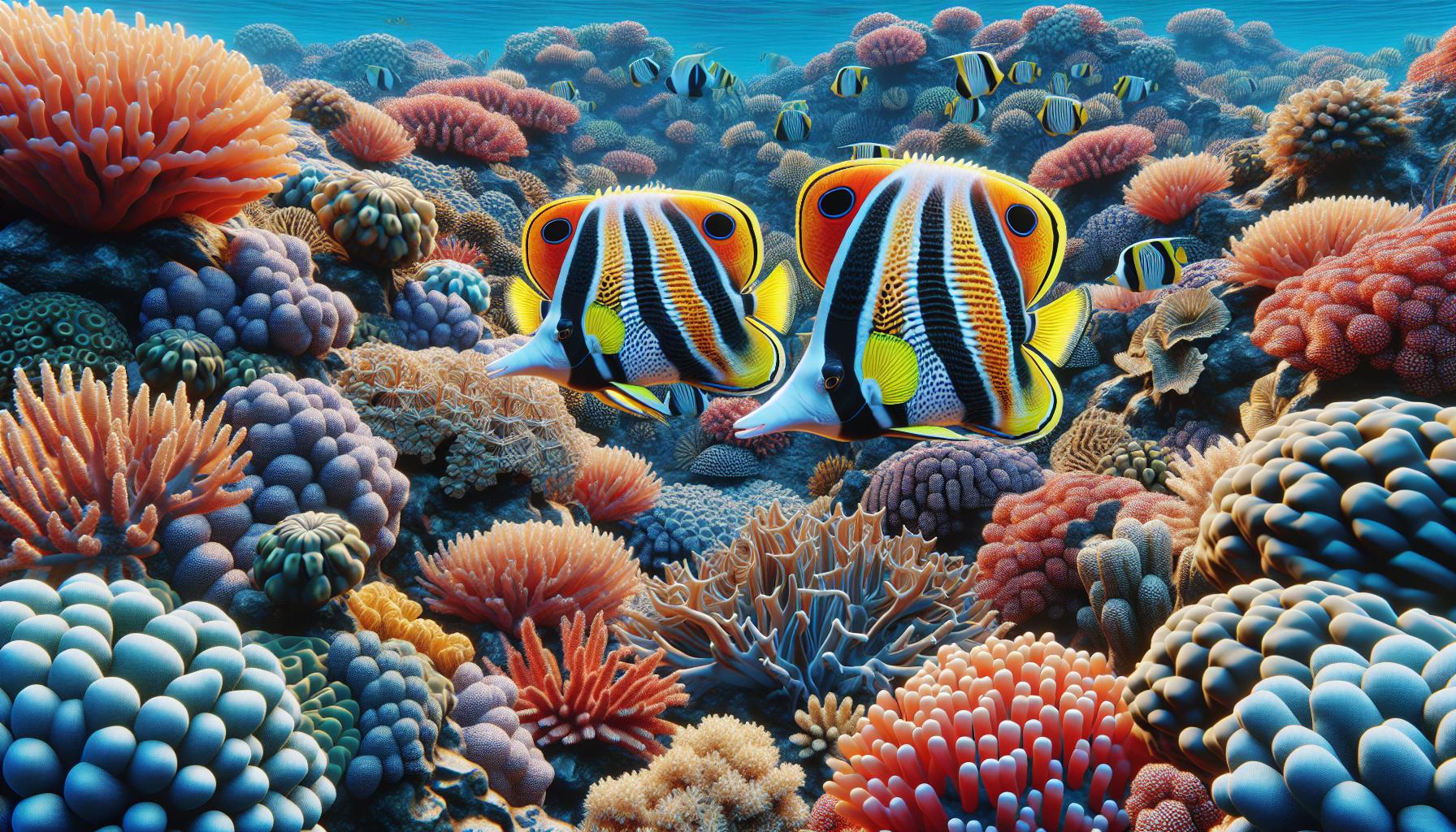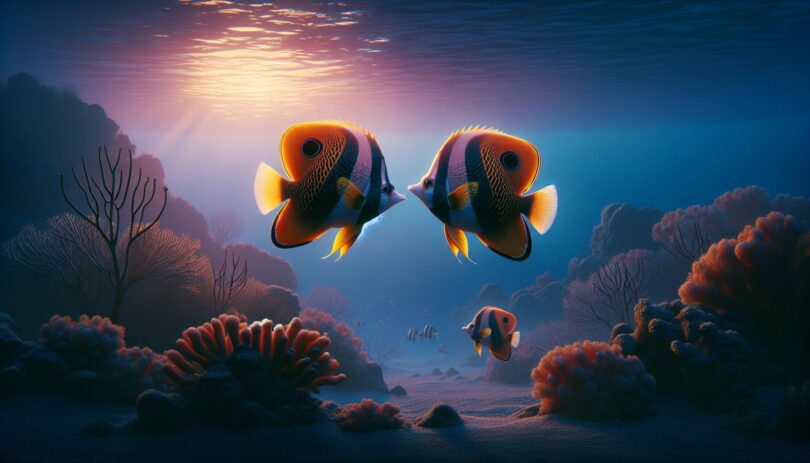Raccoon Butterflyfish, with their striking colors and peaceful nature, have captivated the hearts of many aquarists and marine enthusiasts alike. I’ve always been fascinated by their unique patterns and how they add a splash of brilliance to the underwater world. These fish aren’t just a pretty face; they play a crucial role in their ecosystems, making them a subject worth diving into.
Navigating through the vibrant coral reefs, Raccoon Butterflyfish exhibit behaviors and characteristics that are as intriguing as their appearance. From their dietary habits to their social interactions, there’s so much to learn about these marine beauties. Join me as I explore the enchanting world of Raccoon Butterflyfish, shedding light on what makes them such a fascinating species in the vast ocean.
Key Takeaways
Behavior and Characteristics of Raccoon Butterflyfish

As I delve deeper into the world of Raccoon Butterflyfish, I’ve been captivated by their intriguing behavior and characteristics. These marine creatures exhibit qualities that are not only interesting but also essential for their survival in the wild.
Firstly, it’s crucial to highlight their social behavior. Raccoon Butterflyfish are usually found either solo or in pairs. During my diving adventures, I’ve observed them navigating the reefs with grace, often sticking close to their partners when in pairs. This behavior suggests a level of social interaction that adds another layer to their complexity.
Diet plays a significant role in the life of a Raccoon Butterflyfish. These fish are omnivores, with a preference for corals and invertebrates. Their diet mainly consists of:
- Coral polyps
- Small invertebrates
- Algae
This dietary preference impacts their habitat, as they are commonly found in coral-rich areas where their food sources are abundant. Their feeding habits contribute to the health of coral reefs by controlling the population of certain coral-eating invertebrates.
Another fascinating aspect of their behavior is their adaptability. Raccoon Butterflyfish have shown remarkable resilience in changing environments. They can adapt to various levels of water clarity and reef health, making them a resilient species in the face of environmental changes.
Understanding the behavior and characteristics of Raccoon Butterflyfish provides insight into their role in marine ecosystems. Their social dynamics, dietary habits, and adaptability highlight the complexity of marine life and underscore the importance of conserving their habitats. As I continue to explore the depths of the ocean, I’m constantly reminded of the intricate balance that sustains these ecosystems.
Physical Appearance and Coloration of Raccoon Butterflyfish

When I first laid eyes on a Raccoon Butterflyfish, its stunning appearance caught my attention immediately. These fish boast a distinctive physical structure that sets them apart in the vast marine world. Measuring up to about 8 inches in length, they are not the largest fish in the coral reefs but their striking coloration makes them impossible to miss.
The most notable feature of the Raccoon Butterflyfish is, without a doubt, its unique facial mask. This dark, raccoon-like mask covers their eyes, which serves not just as an intriguing visual characteristic but also as a form of protection against predators. The contrast between the mask and their bright yellow bodies is truly mesmerizing.
Their bodies are predominantly yellow, with black bands that stretch towards the rear, adding to their striking appearance. The dorsal and anal fins of these fish are edged in a delicate shade of blue, providing a beautiful outline against the backdrop of vibrant corals. They also possess a small, yet prominent, black spot on their dorsal fin which aids in confusing predators and protecting them from attacks.
Raccoon Butterflyfish not only captivate the eyes with their beauty but also play a vital role in their ecosystems. Their coloration isn’t just for show; it’s a critical part of their survival strategy in the wild. The bright colors and patterns can communicate various signals, from warding off potential threats to attracting mates.
The blend of their physical features and coloration not only highlights their importance in marine biodiversity but also drives home the necessity of their conservation. Observing these creatures in their natural habitat is a gentle reminder of the delicacy and interconnectedness of ocean life. Their presence enriches the underwater landscape, making it all the more vital to protect these dazzling inhabitants of the sea.
Habitat and Distribution of Raccoon Butterflyfish

Diving into the world of Raccoon Butterflyfish, I’ve discovered their habitats are as fascinating as their striking appearance. These marine creatures prefer the shelter provided by coral reefs, thriving in both shallow lagoons and deeper offshore waters up to 98 feet deep. The versatility of their habitat enables them to play a crucial role in the reef ecosystem, contributing to its health and stability.
Raccoon Butterflyfish have a widespread distribution across the warm waters of the Indo-Pacific. From the eastern coast of Africa, through the Red Sea and the Indian Ocean, to the far reaches of the Pacific Ocean, encompassing areas like Hawaii, Japan, and Australia, their presence is significant. This wide distribution underscores the adaptability and resilience of these fish, traits that have enabled them to survive in diverse marine environments.
Here are some key points on their distribution and habitat:
- Preferred habitats: Coral reefs, shallow lagoons, and deep offshore waters.
- Depth range: Up to 98 feet.
- Geographical spread:
- East coast of Africa
- Red Sea
- Indian Ocean
- Pacific Ocean, including Hawaii, Japan, and Australia
Their expansive distribution is not only a testament to their adaptability but also highlights the importance of conserving diverse marine habitats. Protecting coral reefs, in particular, is crucial for maintaining the populations of Raccoon Butterflyfish and countless other marine species that rely on these ecosystems for survival. By understanding where these fish live and the conditions they need to thrive, we can take better steps toward preserving the delicate balance of our ocean’s ecosystems.
Feeding Habits of Raccoon Butterflyfish
Raccoon Butterflyfish have intriguing feeding habits that fascinate marine enthusiasts and ecologists alike. In my years of exploring marine life, I’ve found that understanding what these fish eat not only sheds light on their behavior but also on the ecological balance of coral reefs.
Primarily, Raccoon Butterflyfish are omnivores. Their diet consists of a variety of marine organisms, but they have a particular preference for coral polyps. This preference places them as key participants in the reef community. By feeding on coral polyps and other invertebrates, they contribute to controlling the growth and health of coral reefs. Alongside coral polyps, their diet includes benthic invertebrates, small crustaceans, and algae.
One fascinating aspect of their feeding habits is their method of hunting. They use their narrow snouts to pick out food from crevices in the coral reefs. This unique feeding strategy allows them to access food sources that many other fish cannot, highlighting their specialized role in their habitat.
| Diet Components | Role in the Ecosystem |
|---|---|
| Coral Polyps | Control coral growth; maintain reef health |
| Benthic Invertebrates | Contribute to invertebrate population balance |
| Small Crustaceans | Aid in crustacean population control |
| Algae | Help in controlling algae growth |
The balance raccoon butterflyfish bring to their ecosystems is delicate. Their feeding habits not only support their survival but also ensure the health and sustainability of coral reefs. The decline of coral reefs due to human activity poses a significant threat to these fish. Their reliance on specific habitats for food makes them susceptible to changes in coral reef health.
I’ve realized the importance of maintaining healthy coral reefs not just for the survival of raccoon butterflyfish but for the myriad of life forms they support. Protecting these marine habitats ensures the survival of complex ecosystems and the incredible biodiversity within them.
Reproduction and Life Cycle of Raccoon Butterflyfish
Understanding the reproduction and life cycle of Raccoon Butterflyfish is vital for appreciating their role in marine environments. I’ve uncovered some fascinating details about these processes that highlight their uniqueness in the aquatic world.
Raccoon Butterflyfish are known for their monogamous pairing during the breeding season. This behavior is relatively rare in the fish kingdom and underscores the complex social structures these creatures exhibit. Mates engage in elaborate courtship displays, which include synchronized swimming and changes in coloration, showcasing the intricacy of their reproductive behaviors.
The spawning process for these fish occurs around dusk, aligning with the lunar cycle. Eggs are released into the open water and are left to drift, depending on the currents for dispersion. This strategy increases the survival rate of the offspring by spreading them over a wide area and reducing the risk of predation.
The eggs of Raccoon Butterflyfish hatch relatively quickly, often within 24 to 48 hours after spawning. The larvae, known as “pelagic”, are initially part of the planktonic community, making them vulnerable to a host of predators. Despite these odds, the larvae that do survive embark on an incredible journey of growth and transformation.
After several weeks of drifting through the ocean’s currents, the juveniles settle in shallow reef areas rich in coral and algae, the essential habitats for their development. Here, they begin their transition into the colorful and active reef dwellers that play a pivotal role in the ecosystem.
Throughout their life cycle, Raccoon Butterflyfish face numerous challenges, from the vulnerability of their larvae to the habitat destruction threatening their adult home. Yet, their reproductive strategies and growth stages are finely tuned to maximize survival. Their monogamous pairing, synchronized spawning, and the perilous journey of their larvae offer a glimpse into the resilience and beauty of marine life.
As these fish advance from eggs to contributing members of the coral reef community, their story is a testament to the complex and interconnected nature of marine ecosystems.
Conclusion
Delving into the world of Raccoon Butterflyfish has been an enlightening journey. From their monogamous pairings and intricate courtship rituals to the challenges their larvae face, it’s clear these creatures are a testament to the resilience and beauty that thrives beneath the waves. Their life cycle, finely attuned to the rhythms of the marine environment, serves as a reminder of the delicate balance within our oceans. As we continue to explore and understand these ecosystems, let’s not forget the critical role each species plays. The story of the Raccoon Butterflyfish isn’t just about survival—it’s a call to preserve the intricate web of life that sustains our planet’s oceans.
Frequently Asked Questions
What kind of social behavior do Raccoon Butterflyfish exhibit during breeding season?
Raccoon Butterflyfish form monogamous pairs and engage in elaborate courtship displays during breeding season, showcasing a strong bond between mating pairs.
How do Raccoon Butterflyfish reproduce?
Reproduction happens around dusk when these fish release their eggs into the open water. The process relies on natural currents to disperse the eggs, which hatch relatively quickly into larvae.
What are the early life stages of Raccoon Butterflyfish like?
After hatching, the larvae, described as “pelagic”, drift with ocean currents for several weeks. This crucial period involves survival through drifting before they settle in shallow reef areas to grow further.
What challenges do Raccoon Butterflyfish face in their lifecycle?
Throughout their lifecycle, they deal with the vulnerability of their larvae and the threat of habitat destruction. These challenges pose significant risks to their survival and population growth.
How do Raccoon Butterflyfish adapt to overcome their challenges?
Their reproductive strategy and growth stages are finely tuned to enhance survival chances. They maximize their resilience through their elaborate courtship, precise spawning timing, and larvae development strategy, showcasing adaptability and resilience in marine life.
Why are marine ecosystems considered interconnected based on the Raccoon Butterflyfish’s life cycle?
The article suggests that the life cycle of Raccoon Butterflyfish, including their reproductive strategies and habitat preferences, plays a role in the broader marine ecosystem, highlighting the interconnectedness and dependency of various marine life forms on each other for survival and prosperity.

